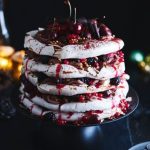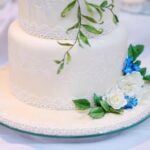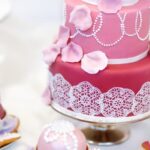Are you looking to take your cake decoration skills to the next level? If so, learning how to make royal icing for decorating cakes is an essential skill to have in your baking repertoire.
Royal icing is a versatile and classic choice for adding beautiful designs and decorations to cakes, cookies, and other baked goods. In this article, we will explore what royal icing is, why it’s the perfect choice for decorating cakes, and provide a comprehensive guide on how to make and use it.
Royal icing is a type of icing that dries to a hard, shiny finish, making it ideal for creating intricate designs and decorations on cakes. Unlike buttercream or fondant, royal icing holds its shape well and is suitable for making delicate details such as lace patterns, flowers, and lettering. Its smooth texture and ability to dry quickly are what make it a popular choice among professional bakers and decorators.
In the following sections, we will delve into the essential ingredients needed to make royal icing and provide step-by-step instructions on how to achieve the perfect consistency. We’ll also explore various color options for tinting royal icing and discuss different decorating techniques, from piping to flooding.
Additionally, we will cover troubleshooting tips for common issues that may arise when working with royal icing and share best practices for storing it. Whether you’re a beginner or seasoned baker, mastering the art of royal icing will elevate your cake decorating game.
Essential Ingredients
Royal icing is a versatile and classic choice for decorating cakes due to its smooth texture and ability to hold intricate designs. To make the perfect royal icing, you will need a few essential ingredients, as well as some special equipment.
The key components of royal icing include egg whites or meringue powder, confectioners’ sugar (powdered sugar), and flavoring such as vanilla extract. In addition to these basic ingredients, you may also need special equipment such as a stand mixer or hand mixer, piping bags, and various tips for creating different designs.
The first step in making royal icing is to ensure that your mixing bowl and utensils are clean and free from any grease or residue. Any impurities can affect the texture and stability of the royal icing.
Next, it’s important to use fresh egg whites or high-quality meringue powder, as this will directly impact the consistency of the icing. For those who prefer not to use raw egg whites, meringue powder is an excellent alternative that can be readily found in baking supply stores.
When preparing royal icing, it’s crucial to sift the confectioners’ sugar before adding it to the other ingredients. This helps prevent lumps in the icing and contributes to a smoother consistency overall. Finally, vanilla extract or other flavorings can be added according to personal preference. It’s important to note that using too much liquid flavoring can alter the consistency of the royal icing.
| Ingredients | Special Equipment |
|---|---|
| Egg whites or meringue powder | Mixing bowl |
| Confectioners’ sugar (powdered sugar) | Stand mixer or hand mixer |
| Flavoring (e.g. vanilla extract) | Piping bags |
Step-by-Step Instructions
Royal icing is a versatile and popular choice for decorating cakes due to its smooth finish and ability to hold intricate designs. Making royal icing at home is a simple process that requires just a few basic ingredients. Here’s how to make royal icing for decorating cakes, along with some helpful tips and tricks for achieving the perfect consistency.
To make royal icing, you will need confectioners’ sugar (powdered sugar), meringue powder, and water. The first step is to sift the confectioners’ sugar to ensure that there are no lumps in the icing. Once sifted, mix the confectioners’ sugar and meringue powder in a clean, grease-free bowl.
Next, add in the water gradually while mixing the ingredients together. It’s important to achieve the right consistency for the royal icing – it should be thick enough to hold its shape when piped but not too stiff that it becomes difficult to work with. If the icing is too thin, add more confectioners’ sugar; if it’s too thick, add small amounts of water until the desired consistency is reached.
For a basic white royal icing, simply leave the mixture as is. If you want to color your royal icing, divide it into separate bowls before adding food coloring. Gel or paste food coloring works best for royal icing as it doesn’t add extra liquid that can alter the consistency of the icing.
Here are some helpful tips for making perfect royal icing:
- Always use grease-free utensils and bowls when making royal icing.
- If using a stand mixer, set it on low speed to avoid incorporating too much air into the icing.
- Keep your royal icing covered with a damp towel or plastic wrap when not in use to prevent it from drying out.
By following these steps and tips, you can easily make your own royal icing at home for decorating cakes and other baked goods.
| Ingredients | Measurements |
|---|---|
| Confectioners’ Sugar (Powdered Sugar) | 4 cups |
| Meringue Powder | 3 tablespoons |
| Water | 6 tablespoons |
Color Options
When it comes to decorating cakes with royal icing, color options are an important aspect of creating visually stunning designs. There are several methods for coloring royal icing, ranging from traditional food coloring to natural alternatives. Here’s how you can achieve a spectrum of vibrant hues for your royal icing creations:
- Traditional Food Coloring: The most common way to color royal icing is by using gel or liquid food coloring. These can be found in a wide range of colors and are readily available at baking supply stores or online. When using food coloring, remember that a little goes a long way, so start with a small amount and gradually add more until the desired shade is reached.
- Natural Alternatives: For those who prefer to avoid artificial colors, there are several natural alternatives that can be used to color royal icing. Ingredients such as beet juice, turmeric, matcha powder, and freeze-dried fruit powders can be used to create rich and vibrant colors without any synthetic additives.
Experimenting with different coloring methods can help you achieve unique shades and tones for your royal icing decorations. Whether you opt for traditional food coloring or natural alternatives, the key is to add the color gradually while mixing the royal icing until you achieve the perfect hue.
By exploring various coloring options, you can unleash your creativity and bring your cake decorating visions to life with beautifully colored royal icing.
Decorating Techniques
Royal icing is the perfect medium for decorating cakes, offering a smooth and elegant finish that can be customized to suit any theme or occasion. Whether you’re looking to create intricate designs or simply add a pop of color, royal icing is versatile and easy to work with. Below you will find a guide on different techniques for using royal icing to decorate cakes.
Piping
One popular way to use royal icing for cake decorating is by piping elaborate designs onto the surface of the cake. To do this, fill a piping bag fitted with a small round tip with your desired color of royal icing and pipe directly onto the cake. You can create fun borders, delicate lace patterns, or even write messages with ease using this method.
Flooding
Another technique involves flooding the surface of the cake with royal icing to create a smooth and even base for decoration. Simply outline the area that you want to flood with a slightly thicker consistency of royal icing, then fill in the space with a more fluid mixture. This allows for seamless coverage and provides a solid foundation for additional details.
Creating Intricate Designs
For those looking to take their cake decorating skills to the next level, royal icing can be used to create stunning and intricate designs. With just a few tools and some patience, you can produce beautiful lacework, 3D flowers, or even lifelike figurines using this versatile medium.
By mastering these various techniques for using royal icing in cake decorating, you’ll be well-equipped to transform any plain cake into a work of art that is sure to impress any crowd. With practice and patience, you can achieve professional-looking results right in your own kitchen.
Troubleshooting
Dealing With Air Bubbles
When making royal icing for decorating cakes, it is not uncommon to encounter air bubbles in the mixture. These pesky bubbles can ruin the smooth texture of the icing and make piping or flooding difficult. To avoid this issue, it is important to mix the royal icing at a low speed and for a longer duration.
Additionally, gently tapping the bowl on the counter and allowing the icing to sit for a few minutes can help release any trapped air bubbles. If air bubbles persist, using a toothpick to carefully pop them can also be effective.
Achieving a Smooth Texture
One of the most frustrating problems when making royal icing is achieving a smooth texture. When the icing is too thick or has lumps, it becomes challenging to work with and can result in uneven decorating. To fix this issue, adding small amounts of water or liquid (such as lemon juice or corn syrup) while mixing can help achieve the desired consistency.
It is crucial to add liquids gradually and mix thoroughly before making any further adjustments. Sifting powdered sugar before adding it to the mixture can also prevent lumps and contribute to a smoother texture.
Preventing Crusting and Drying Out
Another common problem when working with royal icing is its tendency to crust over or dry out too quickly, especially when exposed to air for an extended period. To prevent this issue, cover any unused royal icing with plastic wrap directly on its surface before sealing it in an airtight container.
This will create a barrier that prevents excess air from reaching the surface of the icing, helping maintain its moisture content and preventing premature crusting. Additionally, when not in use, storing royal icing in a cool and dark place can help extend its shelf life and prevent drying out prematurely.
Storage and Shelf Life
Storing royal icing is important to ensure that it maintains its quality and consistency for future use. Proper storage practices can also extend the shelf life of royal icing, allowing bakers to make larger batches and have it on hand whenever needed.
Storage Containers and Conditions
When storing royal icing, it is crucial to use airtight containers to prevent exposure to air and moisture, which can cause the icing to dry out or develop a crust. Plastic or glass containers with secure lids are ideal for this purpose. Additionally, royal icing should be kept at room temperature in a cool, dry place away from direct sunlight.
Shelf Life of Royal Icing
Properly stored royal icing can last for several weeks, if not months. The exact shelf life will depend on the specific recipe used and how well it is stored. It is important to check the consistency and odor of the icing before using it after an extended period of time. If the icing has become too thick or has an off smell, it may have spoiled and should be discarded.
Freezing Royal Icing
For even longer-term storage, royal icing can be frozen. It should be placed in a freezer-safe container and sealed tightly to prevent freezer burn. Before using frozen royal icing, allow it to thaw at room temperature and then re-mix it to restore the original texture and consistency.
By following these best practices for storing royal icing, bakers can ensure that they always have this versatile decorating tool on hand for their cake decorating needs. Whether making intricate designs or simple borders, properly stored royal icing will be ready whenever inspiration strikes.
Alternative Uses
In conclusion, royal icing is a versatile and essential component for anyone interested in the art of cake decorating. By mastering the creation of this smooth, hard-drying icing, you will have a valuable tool in your baking repertoire.
Not only is it easy to make, but it also provides a beautiful finish to cakes, cookies, and other baked goods. Whether you are a beginner or an experienced baker, understanding how to make royal icing for decorating cakes will elevate your creations to a whole new level.
Furthermore, once you have perfected your royal icing technique, there are numerous ways to use any leftovers. From making edible decorations like flowers and leaves to adding embellishments to cookies or gingerbread houses, the possibilities are endless. You can even use royal icing as “glue” for constructing gingerbread structures or binding together cake layers. Embracing alternative uses for royal icing ensures that nothing goes to waste and allows you to add personalized touches to all your baked creations.
Lastly, with proper storage techniques in mind, leftover royal icing can be kept for future use. It is important to store it correctly in an airtight container at room temperature or in the refrigerator if needed. By doing so, you can extend its shelf life and have it readily available whenever inspiration strikes. So don’t let any extra royal icing go to waste – get creative and explore the many ways it can enhance your baking projects.
Frequently Asked Questions
How to Make Royal Icing Quickly?
Making royal icing quickly involves combining powdered sugar, meringue powder, and water in a mixing bowl. Beat the mixture on low speed until it becomes fluffy and glossy, then adjust the consistency as needed with additional water or powdered sugar.
Can I Put Royal Icing Directly on a Cake?
While you can put royal icing directly on a cake, it’s important to consider the texture of the icing. If it’s too runny, it may not hold its shape well on the cake. It’s best to use thicker royal icing for decorating cakes.
How Do You Decorate With Royal Icing for Beginners?
For beginners, decorating with royal icing can be approached by starting with simple designs like polka dots or lines. Using a piping bag and different tips can help create varied patterns and textures. Practice piping on parchment paper before decorating baked goods to build skill and confidence.

Welcome to my blog about home and family. This blog is a place where I will share my thoughts, ideas, and experiences related to these important topics. I am a stay-at-home mom with two young children. I hope you enjoy reading it! and may find some helpful tips and ideas that will make your home and family life even better!





